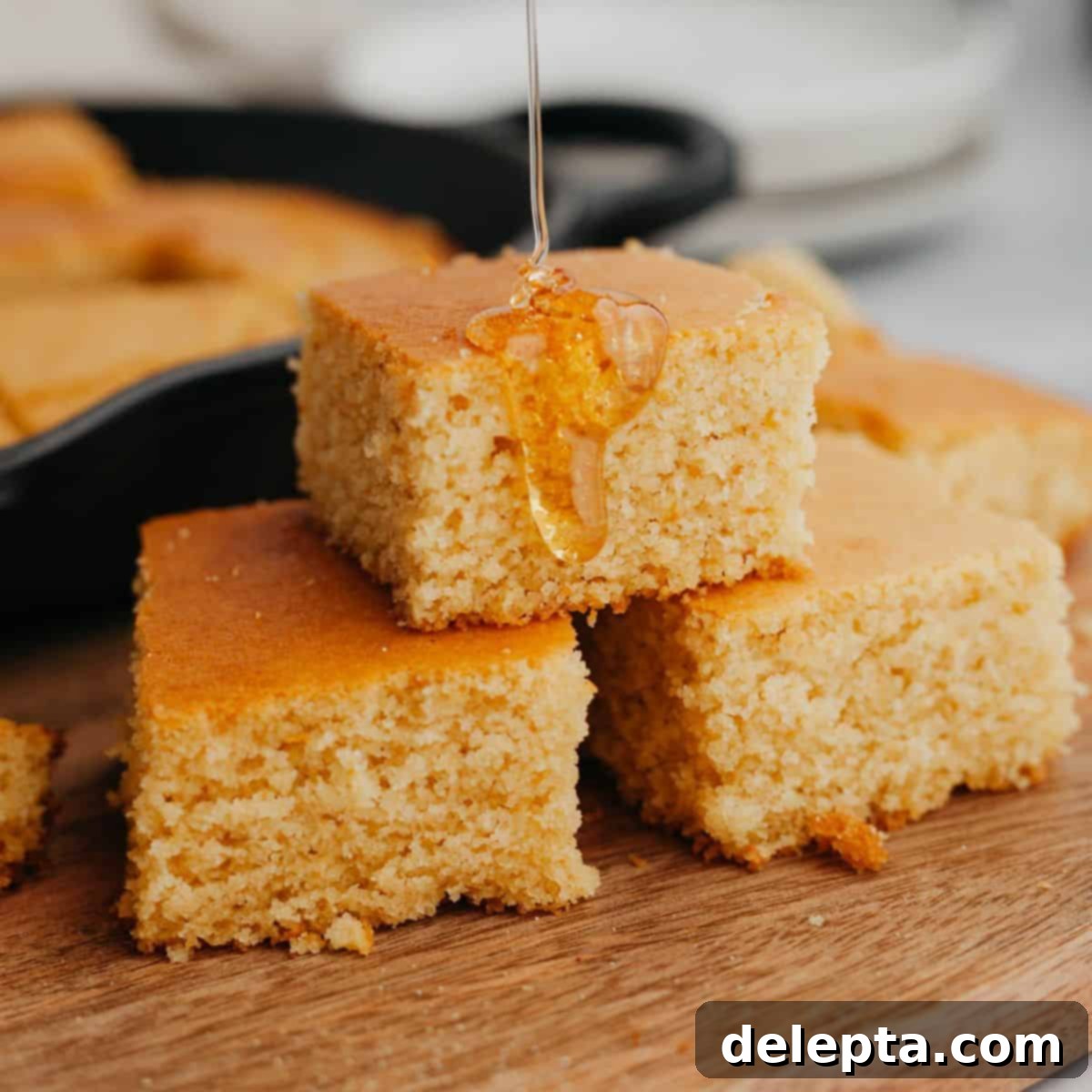Easy Buttermilk-Free Cornbread Recipe: Moist, Buttery, and Perfect Every Time
Are you a devoted fan of soft, impossibly buttery, and perfectly moist cornbread? If so, you’re in for a treat! This golden cornbread recipe is designed for ultimate simplicity and flavor, requiring only 5 minutes of preparation and no electric mixer. My favorite way to achieve that irresistible, crisp crust is by baking it in a trusty cast iron pan – a secret that elevates this homemade cornbread to a whole new level of deliciousness. Get ready to bake a batch that will become a staple in your kitchen!
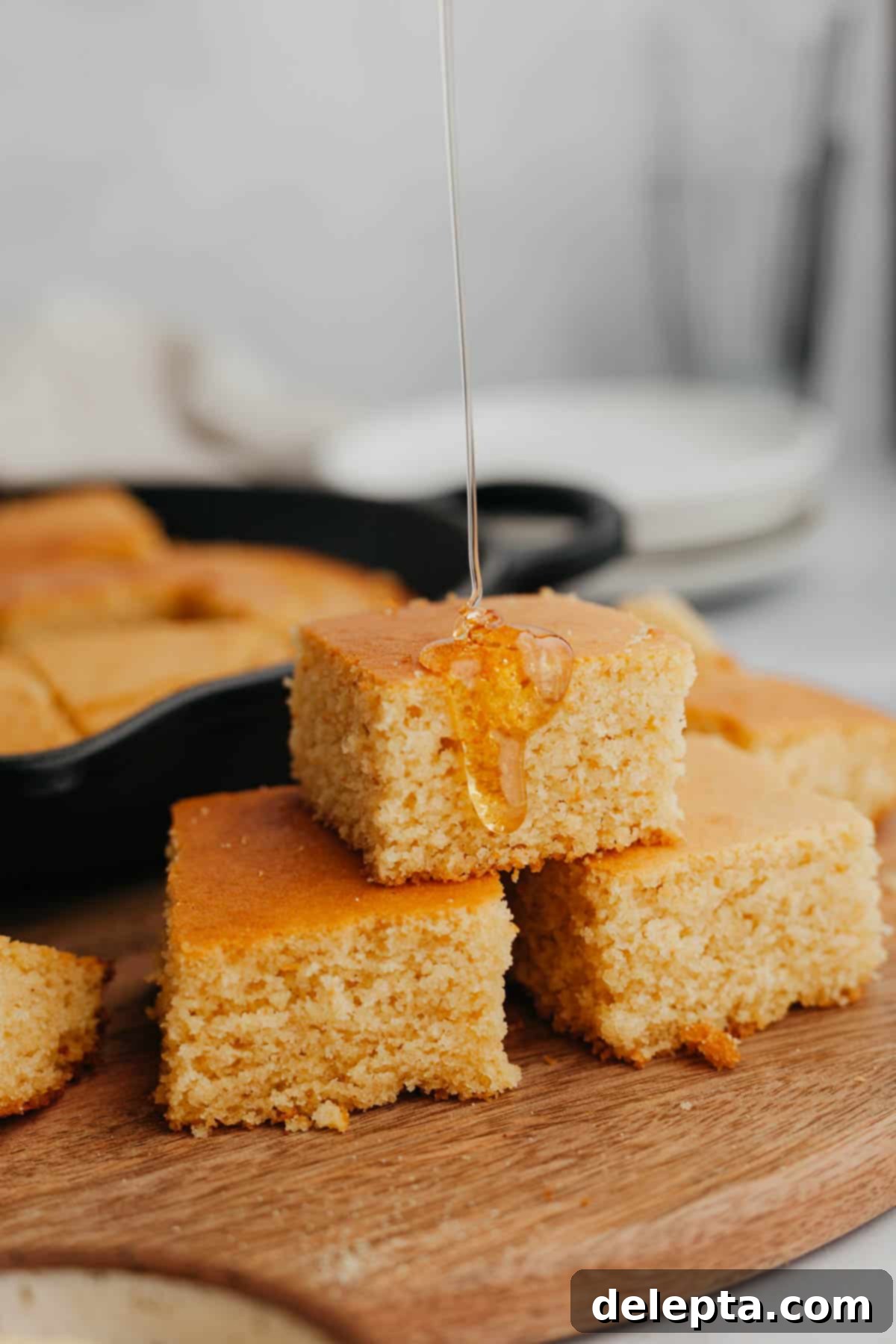
Cornbread holds a special place in my heart as one of the most comforting savory bakes. There’s something truly satisfying about a slice that’s tender, rich with butter, and boasts just a hint of natural sweetness from honey. This easy, homemade cornbread recipe is not only incredibly versatile but also incredibly quick to whip up, making it the ideal dish to have in your culinary repertoire for any occasion, whether it’s a cozy family dinner or a festive gathering.
This delightful cornbread isn’t just a treat for the taste buds; it’s also the quintessential side dish that complements a wide array of meals. Just imagine serving a warm, fragrant slice alongside a hearty bowl of three-bean chili, stew, or your favorite barbecue. Its subtle sweetness and rich texture create a beautiful contrast, soaking up all the savory flavors and adding an extra layer of comfort to your dinner table.
[feast_advanced_jump_to]
Why You’ll Absolutely Love This Easy Cornbread Recipe!
This buttermilk-free cornbread isn’t just another recipe; it’s a culinary game-changer designed for maximum flavor and minimal fuss. Here’s why this particular recipe will quickly become your go-to for golden, moist, and utterly delicious cornbread:
- No Buttermilk Required: Pure Convenience!
Let’s be honest, how often do you have buttermilk readily available in your fridge? For many of us, it’s a specialty ingredient that requires an extra trip to the grocery store. This recipe liberates you from that inconvenience! I specifically developed this simple cornbread without buttermilk so you can enjoy a warm, homemade batch whenever the craving strikes, without any last-minute detours. It’s perfect for those spontaneous baking moments when you want delicious results without compromising on texture or flavor.
- Extra Buttery Goodness: Rich & Indulgent!
If you believe, like I do, that butter makes everything better, then this cornbread is for you! We incorporate a generous amount of melted unsalted butter directly into the batter, ensuring every bite is infused with a deep, rich, and truly buttery flavor. This not only contributes to its luxurious taste but also plays a crucial role in achieving that wonderfully moist and tender crumb texture that cornbread connoisseurs adore.
- A Perfect Hint of Sweetness: Balanced Flavor!
Some prefer their cornbread savory, others sweeter. This recipe strikes a delightful balance! A thoughtful combination of light brown sugar and a touch of golden honey lends this cornbread a subtle, nuanced sweetness that’s incredibly appealing without being overpowering. It complements the corn flavor beautifully, making it versatile enough to pair with both sweet and savory dishes, from chili to a drizzle of extra honey.
- No Mixer Needed: Effortless Preparation!
Forget about lugging out heavy appliances or dealing with messy cleanup. This streamlined recipe requires absolutely no electric mixer. All you need are a couple of bowls or a large jug, a whisk, and a rubber spatula or wooden spoon. It’s a true one-bowl wonder (or two, if you count the wet ingredients), making preparation incredibly fast and cleanup a breeze. This hands-on approach also helps prevent overmixing, which is key to a tender cornbread.
Essential Ingredient Notes for Your Best Cornbread
Crafting truly exceptional cornbread starts with understanding the role of each ingredient. Here’s a detailed look at what you’ll need and why it matters for this simple, buttermilk-free recipe:
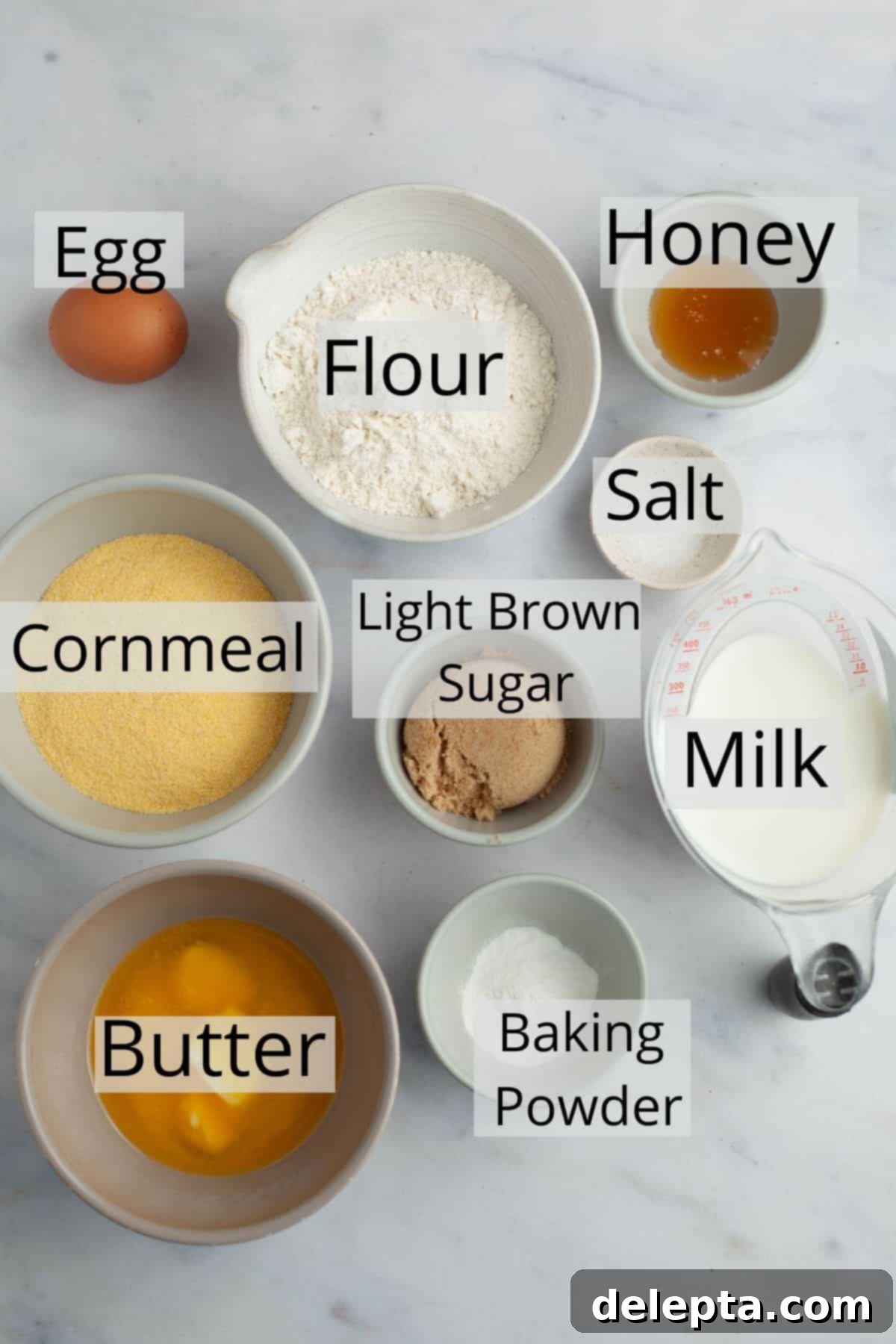
Unsalted Butter: I always opt for unsalted butter in my baking. This gives me complete control over the total salt content in the recipe, allowing the other flavors to truly shine. For an even richer, more luxurious cornbread, consider using a high-quality European-style butter, which typically has a higher butterfat content. This extra fat translates directly into a more flavorful and tender crumb.
All-Purpose Flour: This recipe has been meticulously tested and perfected using standard all-purpose flour. Its balanced protein content provides just enough structure without making the cornbread tough. While other flours might work, I recommend sticking to all-purpose for guaranteed results, especially if you’re making this for the first time.
Yellow Cornmeal: The star of the show! You’ll need yellow cornmeal for that classic golden hue and authentic corn flavor. The grind of your cornmeal can affect texture; a medium grind offers a nice balance of chewiness and tenderness, while a fine grind will yield a softer, more cake-like texture. Avoid instant or self-rising cornmeal, as they contain added leavening and salt that will throw off the recipe’s balance.
Honey: Beyond just adding sweetness, honey brings a lovely depth of flavor and helps contribute to the moistness of the cornbread. Its natural sugars also assist in creating that beautiful golden-brown crust. Any good quality honey will work perfectly, from a delicate clover to a robust wildflower variety.
Whole Milk: For the richest flavor and most tender crumb, whole milk is my preferred choice. Its fat content enriches the batter and helps create a wonderfully moist texture. If you’re looking for a dairy-free alternative, unsweetened almond milk or oat milk can be successfully substituted, though the final texture might be slightly less rich.
Baking Powder: This crucial leavening agent is what gives our cornbread its beautiful rise and airy texture. Ensure your baking powder is fresh for optimal results; if it’s expired, your cornbread might turn out dense. This is the primary leavener, as we’re not using buttermilk which typically reacts with baking soda.
Light Brown Sugar: Working in harmony with the honey, light brown sugar provides additional sweetness and helps keep the cornbread exceptionally moist due to its molasses content. It also imparts a subtle caramel-like note that enhances the overall flavor profile.
Large Egg: The egg acts as a binder, holding all the ingredients together and providing structure. Using a large, room-temperature egg is important as it incorporates more evenly into the batter, leading to a smoother mixture and a more consistent final product.
Kosher Salt: A touch of salt is essential to balance the sweetness and enhance all the other flavors in the cornbread. It prevents the taste from being flat and brings out the earthy notes of the cornmeal. If using table salt, remember to halve the amount, as kosher salt has larger crystals and is less dense.
Easy Step-by-Step Instructions to Bake Perfect Cornbread
Making this buttery, moist cornbread is incredibly straightforward and designed for ease. Follow these simple steps for a golden, crispy-edged delight:
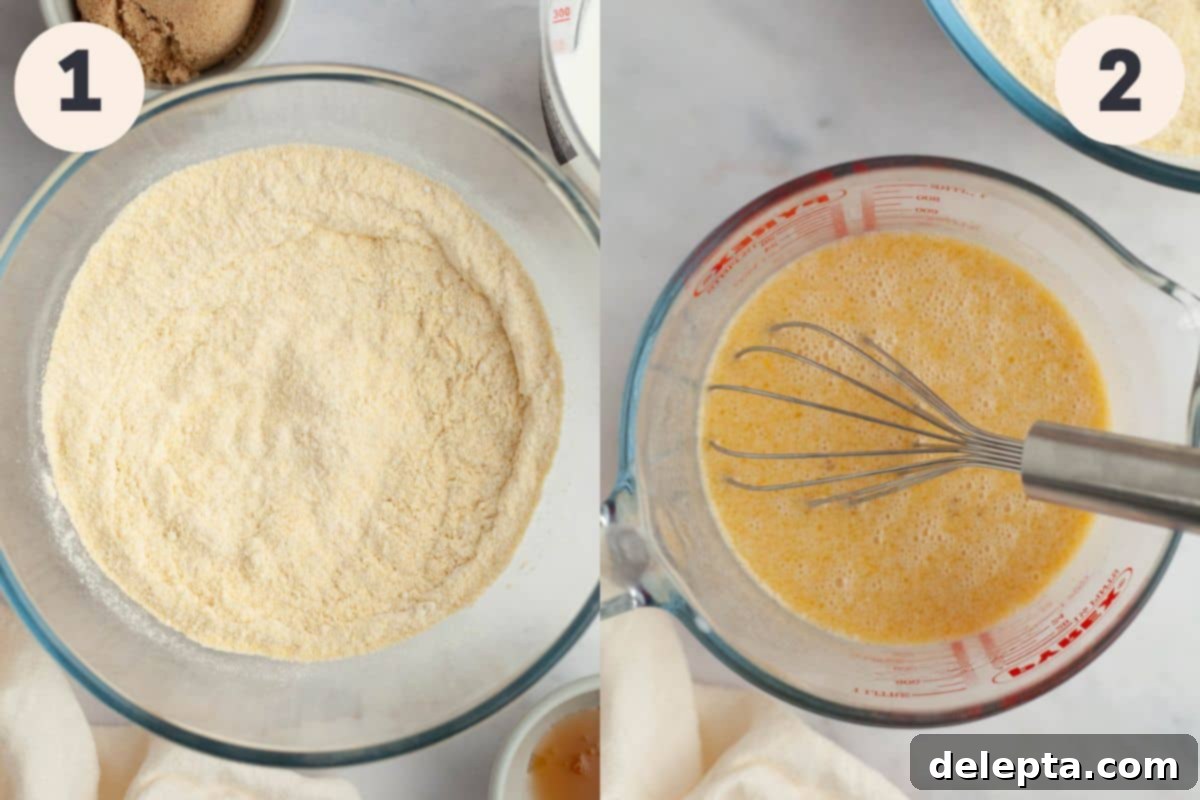
Step 1: Prepare the Dry Ingredients. In a large mixing bowl, combine the cornmeal, all-purpose flour, baking powder, and kosher salt. Use a whisk to thoroughly blend these dry ingredients together until they are uniform and smooth. This ensures that the leavening agent (baking powder) is evenly distributed throughout, leading to a consistent rise in your cornbread.
Step 2: Whisk the Wet Ingredients. In a separate large jug or a second mixing bowl, whisk together the room-temperature egg, light brown sugar, honey, whole milk, and melted unsalted butter. Continue whisking until the mixture is completely smooth and well combined. Ensure the butter isn’t too hot, as it could scramble the egg; it should be just warm enough to be fully liquid.
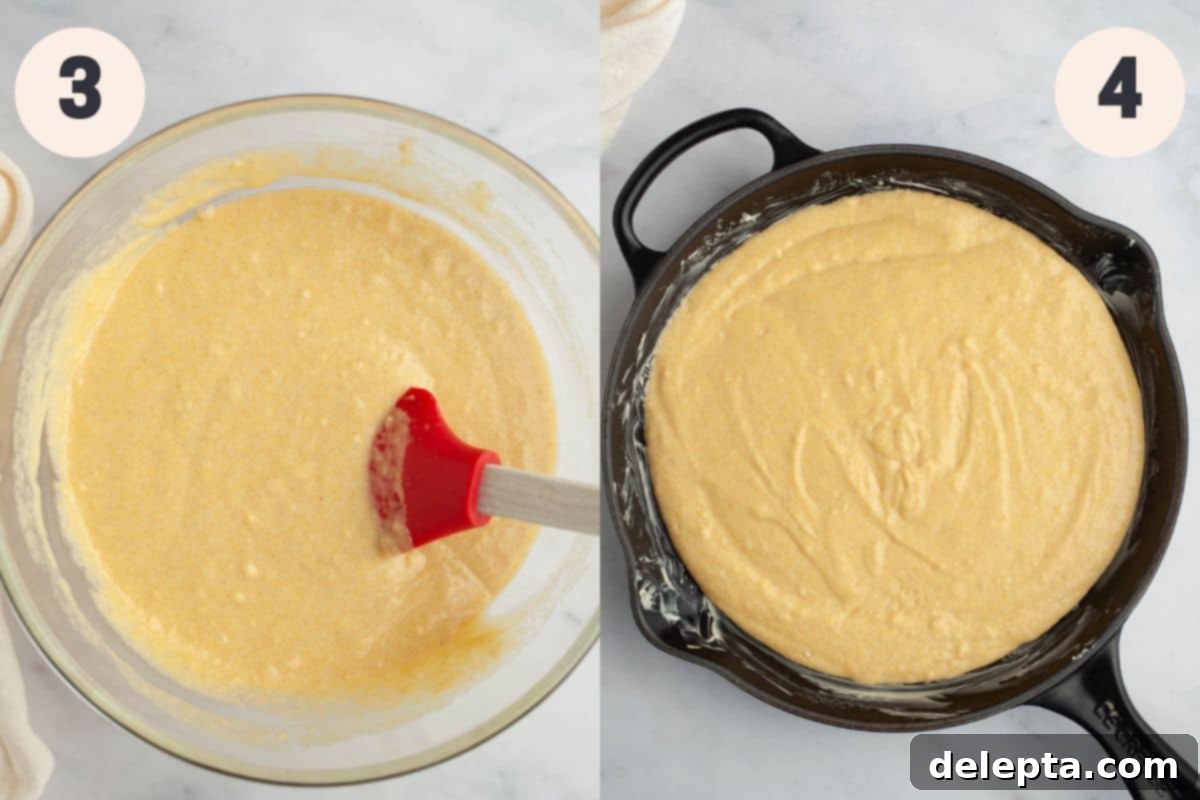
Step 3: Combine Wet and Dry Mixtures. Pour the wet ingredients directly into the bowl with the dry ingredients. Using a rubber spatula or a wooden spoon, gently mix everything together. Stir just until the ingredients are moistened and mostly smooth. It’s perfectly fine if there are a few small lumps; overmixing can lead to a tough cornbread, so stop as soon as everything is incorporated.
Step 4: Bake to Golden Perfection. Carefully pour the cornbread batter into your pre-greased 9-inch cast-iron skillet. Ensure the oven is preheated to 400°Fahrenheit (200°Celsius) before placing the skillet inside. Bake for 18-20 minutes, or until the top is beautifully golden brown and a wooden skewer inserted into the center comes out clean. Be very cautious when removing the hot cast iron skillet from the oven! Allow the cornbread to cool in the skillet for at least 10-15 minutes before attempting to slice and serve. This cooling time helps the cornbread set and prevents it from crumbling.
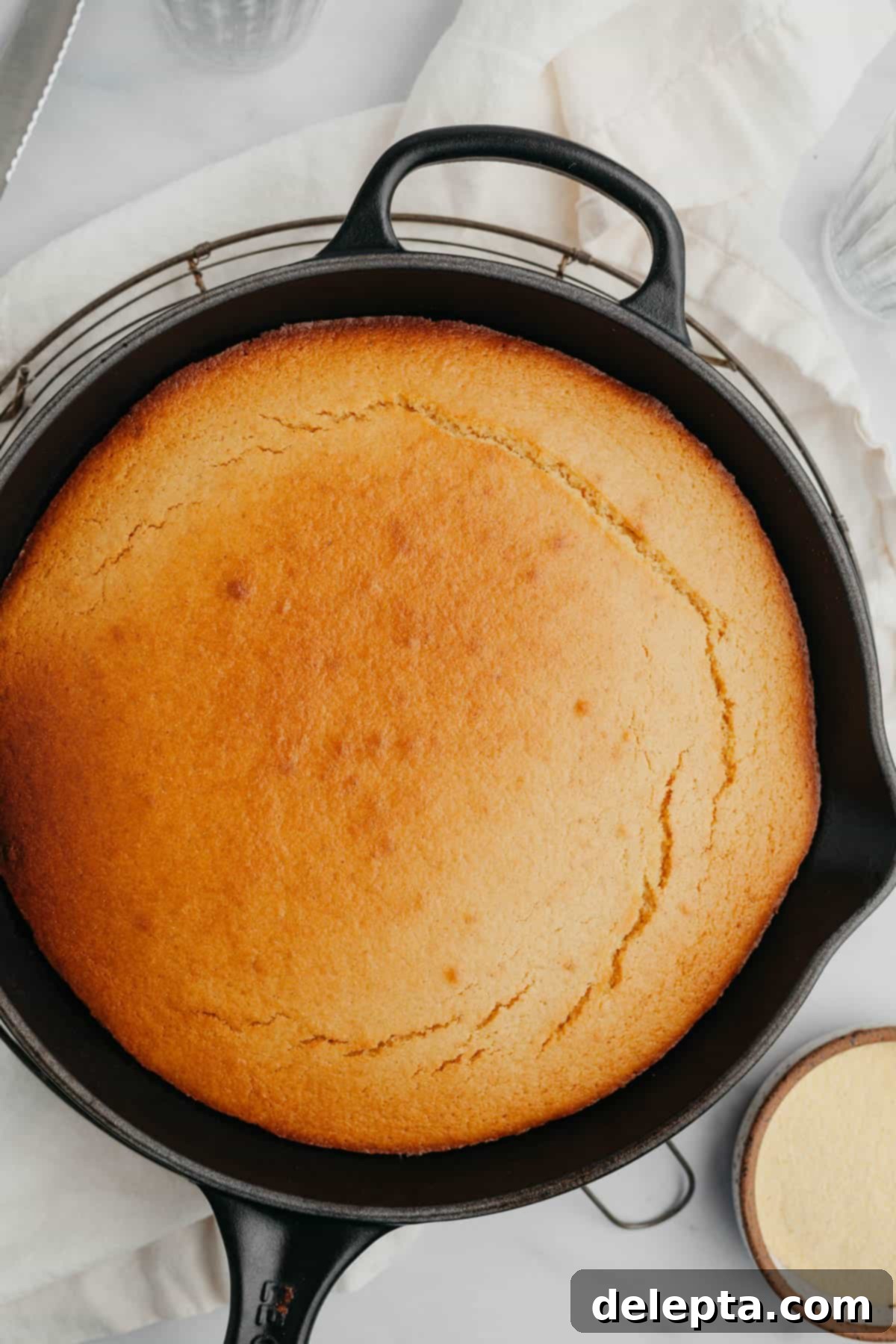
Top Tips & Tricks for Irresistible Cornbread
Achieving perfectly moist and flavorful cornbread is easy with these simple yet effective tips:
- Embrace a Weighing Scale for Precision: For consistently perfect baked goods, I cannot stress enough the importance of using a digital kitchen scale. Measuring ingredients, especially flour and cornmeal, by weight (metric grams are often most accurate) eliminates discrepancies that can occur with cup measurements, which can vary significantly depending on how ingredients are scooped. This will make a huge difference in the texture and overall success of your cornbread.
- Master the “Fluff and Sprinkle” Method for Flour: If you absolutely must measure your flour using cups, ensure you’re doing it correctly to avoid a dense or dry cornbread. Gently fluff the flour in its container, then spoon it lightly into your measuring cup, without packing it down. Level off the top with the back of a knife. Never scoop directly from the bag, as this compacts the flour and can add up to 25% more than intended. For a visual guide, check out this helpful link on how to measure flour the right way. Too much flour is the enemy of moist crumbs!
- No Cast Iron Skillet? No Problem!: While a cast iron skillet is highly recommended for its ability to create that signature crispy crust and even heat distribution, it’s not strictly essential. You can achieve excellent results using a regular 9-inch cake pan, an 8×8 inch square baking dish, or a pie dish. Just be sure to grease it thoroughly. Keep in mind that the edges and bottom might not be as golden or deeply crispy as those achieved with cast iron, but your cornbread will still be delicious and moist.
- Ensure All Ingredients are at Room Temperature: This might seem like a small detail, but it’s crucial for the texture of your cornbread. Room temperature ingredients (especially the egg and milk) combine much more smoothly and evenly into the batter, preventing lumps and ensuring a uniform consistency. This leads to a finer, more tender crumb in the final baked product. Plan ahead and take your refrigerated ingredients out 30-60 minutes before you start baking.
- Don’t Overmix the Batter: Once you combine the wet and dry ingredients, mix just until everything is moistened and no streaks of dry flour remain. A few small lumps are completely normal and preferable to an overmixed, tough cornbread. Overmixing develops the gluten in the flour too much, resulting in a dense, chewy texture rather than a light and tender one.
- Preheat Your Skillet for an Extra Crispy Crust: For an even crispier bottom crust, try preheating your greased cast iron skillet in the oven for about 5-10 minutes while the oven comes to temperature and you prepare the batter. Pouring the batter into a hot skillet helps it start cooking immediately, creating a beautiful sear on the bottom.
Frequently Asked Questions About Cornbread
Here are some common questions about making and enjoying this delicious cornbread:
Absolutely! While a cast iron skillet is fantastic for achieving that signature crispy crust and even heat, you can certainly use a regular 9-inch round cake pan, an 8×8 inch square baking dish, or a pie plate. Just ensure it’s well-greased to prevent sticking. Keep in mind that the edges and bottom of the cornbread might not develop the same level of golden-brown crispness as they would in cast iron, but the flavor and moistness will still be outstanding.
The topping possibilities are endless! For a simple yet satisfying treat, top your warm, freshly baked cornbread with a pat of butter, a drizzle of extra honey, or a sprinkle of flaky sea salt to enhance its flavors. For savory variations, consider adding chopped jalapeños or fresh corn kernels directly into the batter before baking. Other delicious toppings include maple syrup, jam, homemade apple butter, or serving it alongside a hearty bowl of chili, stew, or pulled pork for the ultimate comfort food experience.
To maintain its freshness and moisture, store any leftover cornbread in an airtight container at room temperature for up to 2 days. If you want to keep it longer, cornbread freezes beautifully! Wrap individual slices or the whole loaf tightly in plastic wrap, then place it in a freezer-safe bag or container for up to 2 months. When you’re ready to enjoy it, simply allow it to thaw overnight in the refrigerator, then warm it gently in the microwave or a toaster oven for a fresh-baked taste.
Yes, you can easily adjust the sweetness to make it more savory! While this recipe has a touch of honey and brown sugar, you can reduce the amount of both if you prefer a less sweet profile. Additionally, consider folding in savory mix-ins like shredded cheddar cheese, diced jalapeños, crumbled bacon, or chives into the batter before baking. These additions will transform it into a wonderful accompaniment for soups, stews, or barbecue.
Dry or crumbly cornbread is often a result of overmixing the batter or using too much flour. When you overmix, you develop the gluten in the flour, leading to a tough texture that can feel dry. Ensure you mix just until the ingredients are combined. Also, measuring flour accurately (ideally by weight) is key. If you pack flour into your measuring cup, you could be adding significantly more than the recipe calls for, resulting in a drier crumb. Make sure your baking powder is also fresh for proper leavening and a tender texture.
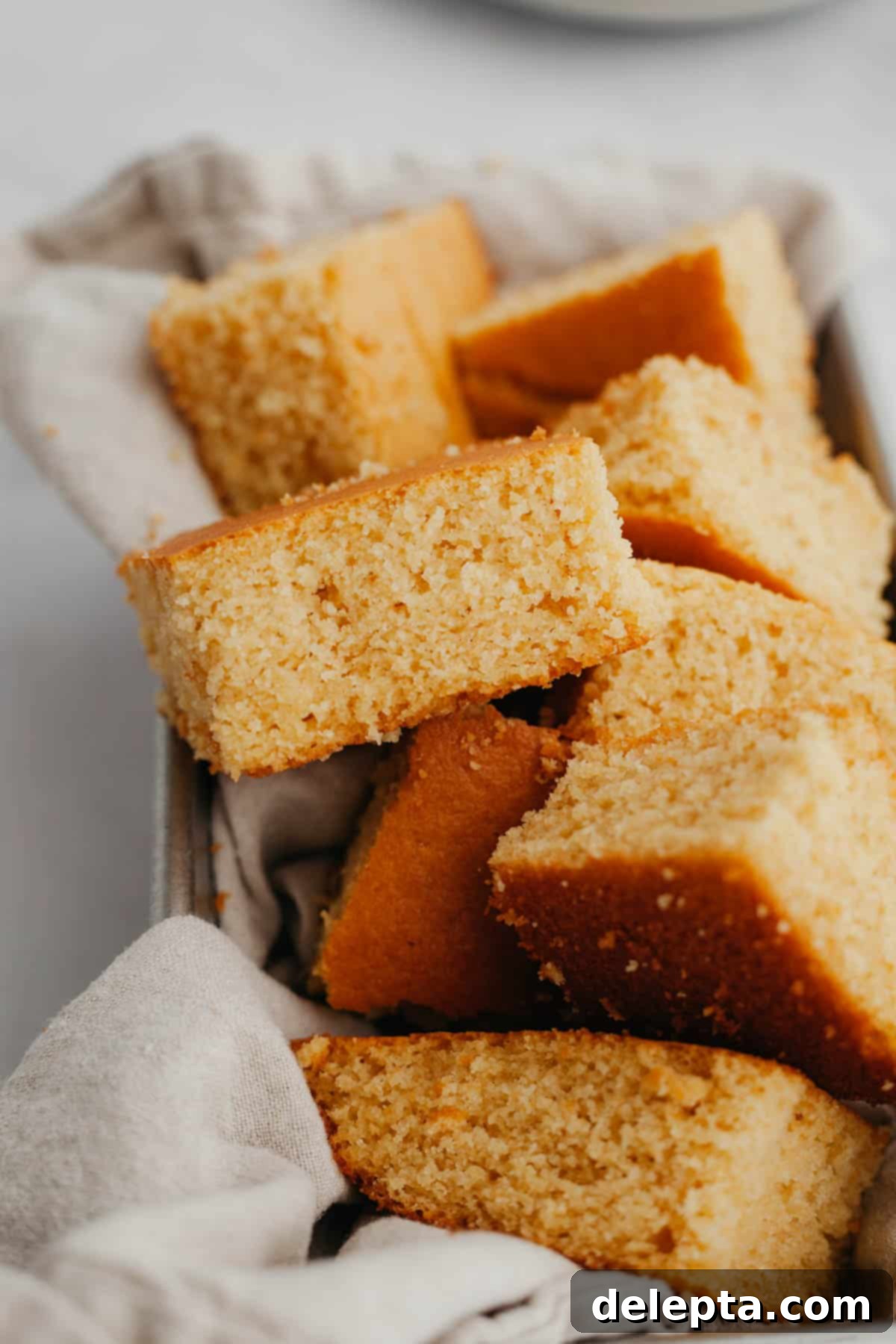
Expand Your Baking Repertoire: Try These Simple Recipes Next!
If you loved this easy and delicious cornbread, you’ll surely enjoy exploring more simple and delightful recipes. Here are some hand-picked favorites that are perfect for any home baker:
- Simple Lotus Biscoff Cake
- Nutella Baked Oats
- Easy Banana Carrot Muffins
- Cinnamon Donuts (15 Minutes)
Have you made this incredible cornbread recipe? We’d love to hear from you! Please take a moment to rate the recipe below. Don’t forget to share your delicious creations and follow me on Instagram @alpineella and Pinterest! Your feedback and photos truly inspire me.
Recipe Card: Buttermilk-Free Cornbread
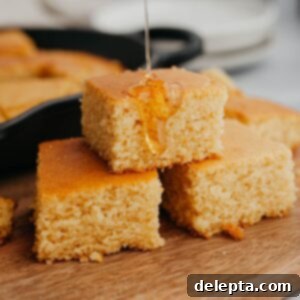
Cornbread without buttermilk
Ella Gilbert
Pin Recipe
Save RecipeSaved!
Equipment
-
1 9 inch cast iron skillet (or similar sized baking pan)
-
Large mixing bowl
-
Whisk
-
Rubber spatula or wooden spoon
Ingredients
- 1 cup yellow cornmeal
- 1 cup all purpose flour
- ⅓ cup light brown sugar
- 2 ½ teaspoons baking powder
- ¼ teaspoon kosher salt
- 1 cup whole milk
- ⅓ cup melted unsalted butter
- 1 large egg room temperature
- 1 tablespoon honey
Instructions
-
Preheat your oven to 400°Fahrenheit (200°Celsius). Generously butter your 9-inch cast iron skillet or chosen baking pan. If using cast iron, you can preheat the empty, greased skillet in the oven for 5-10 minutes for an extra crispy crust.
-
In a large bowl, whisk together the yellow cornmeal, all-purpose flour, light brown sugar, baking powder, and kosher salt until well combined and lump-free.
-
In a separate jug or medium mixing bowl, whisk together the room-temperature large egg, honey, whole milk, and melted unsalted butter until the mixture is smooth and fully incorporated.
-
Pour the liquid (wet) ingredients into the dry ingredients. Using a wooden spoon or rubber spatula, gently mix everything together. Stir just until the dry ingredients are moistened and almost smooth. A few small lumps are normal; avoid overmixing to ensure a tender cornbread.
-
Immediately pour the prepared cornbread batter into your hot, greased skillet or baking pan. Bake for 18-20 minutes, or until the top is golden brown and a toothpick inserted into the center comes out clean. Carefully remove the hot skillet from the oven and let the cornbread cool for at least 10-15 minutes before slicing and serving. This resting time is crucial for the cornbread to set and firm up.
Notes
To ensure smooth mixing and the best texture, always make sure all of your refrigerated ingredients, especially the egg and milk, are at room temperature before you begin baking. Pull them out about 30-60 minutes in advance.
Butter: For an exceptionally rich and creamy cornbread, I recommend using a high-quality European-style butter, such as Kerry Gold, which boasts a higher butterfat content.
Salt: If you don’t have kosher salt on hand, you can substitute with fine table salt, but remember to halve the amount called for in the recipe. As a general rule, 1 teaspoon of kosher salt is equivalent to about ½ teaspoon of fine table salt.
Storage: Keep any leftover baked cornbread in an airtight container at room temperature for up to 2 days. For longer storage, you can freeze the cornbread for up to 2 months. Simply defrost it overnight in the fridge, then gently warm slices in the microwave or a toaster oven before serving to restore its delicious texture.
Nutrition
